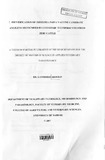| dc.contributor.author | Akoolo, L | |
| dc.date.accessioned | 2013-05-08T07:33:05Z | |
| dc.date.available | 2013-05-08T07:33:05Z | |
| dc.date.issued | 2007 | |
| dc.identifier.citation | Akoolo, L(2007). Identification of theileria parva vaccine candidate antigens recognised by cytotoxic t lymphocytes from Zebu cattle | en |
| dc.identifier.uri | http://erepository.uonbi.ac.ke:8080/xmlui/handle/123456789/20085 | |
| dc.description | Msc-Thesis | en |
| dc.description.abstract | East Coast fever (ECF), caused by Theileria parva, a tick-borne intracellular
apicomplexan parasite, is a highly fatal lymphoproliferative disease of cattle. Immunity
against T. parva has previously been shown to be mediated through lysis of schizont
infected cells by Major histocompatibililty complex (MHC) class I restricted CD8+
cytotoxic T lymphocytes (CTL). A strategy has recently been developed to identify CTL
target schizont antigens and has provided a solid basis for the development of a subunit
vaccine against ECF.
To date CTL target antigens have been identified using CTL derived from Bos taurus and
Boran (B. indicus) cattle immunised with the Muguga stock of T. parva. It has been
hypothesised that additional antigens are required to formulate a sub-unit vaccine that
would protect the out bred cattle population at risk from a highly heterogeneous T. parva
population. This study aimed to extend and expand the process of vaccine candidate
antigen identification by employing CTL obtained from genetically diverse East African
zebu cattle immunised with the cocktail of T .parva stocks that constitute the FAO 1 live
vaccine that protects cattle across the ECF endemic areas. T. parva specific CD8+
polyclonal CTL lines were generated by repeated in vitro stimulation of peripheral blood
mononuclear cells (PBMCs) from ITM immunised zebu cattle with T. parva infected
lymphoblasts. CTL were confirmed to express a CD3+ CD8+ phenotype and specifically
lyse autologous T. parva infected cells in 5 IChromium release cytotoxicity assays. CTL
lines were tested for recognition of immortalised skin fibroblasts (iSF) infected with
recombinant Modified Vaccinia Ankara strain (MV A) viruses expressing the previously
identified schizont antigens. Only CTL from one calf (BY 120), showed specific
recognition of these antigens; CTL responded specifically to iSF infected with MVA
expressing antigen Tp2. Synthetic peptides were employed to identify a novel CTL
epitope and analysis of the consensus sequences of positive peptides suggested that the
minimal length antigenic peptide was the 10mer Tp2138-147 (KTSIPNPCKW). CTL were
next used to immunoscreen iSF transiently transfected with 96 cDNA encoding
secreted/membrane bound proteins and 644 cDNA pools derived from a T parva
(Muguga) schizont cDNA expression library. CTL from calf BY126 specifically
responded to two cDNA pools. All the other CTL failed to recognize transfected iSF.
This study has demonstrated that CTL isolated from Zebu cattle immunized with a
cocktail of T parva stocks recognize novel schizont antigens and continued
immunoscreening is required to identify these antigens, which will constitute valuable
additions to the vaccine candidates currently being evaluated. | en |
| dc.description.sponsorship | University of Nairobi | en |
| dc.language.iso | en | en |
| dc.subject | Theileria parva vaccine | en |
| dc.subject | Antigens | en |
| dc.subject | Cytotoxic T Lymphocytes | en |
| dc.subject | Zebu Cattle | en |
| dc.title | Identification of theileria parva vaccine candidate antigens recognised by cytotoxic t lymphocytes from Zebu cattle | en |
| dc.type | Thesis | en |
| local.publisher | Department of Veterinary Pathology, Microbiology and Parasitology, University of Nairobi | en |

